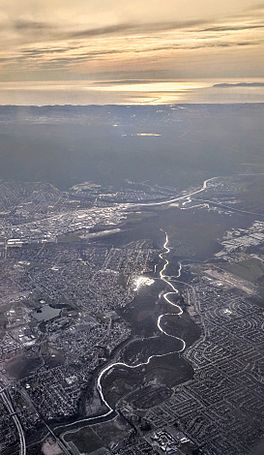Prado Reservoir facts for kids
Quick facts for kids Prado Reservoir |
|
|---|---|

Aerial view of the Santa Ana River, looking into the afternoon sun, where the river forms the boundary between Norco (left) and Eastvale (right) and flows into the Prado Flood Control Basin before highways 91 and 71. Santa Catalina Island in the distance.
|
|
| Location | Riverside / San Bernardino counties, California, US |
| Coordinates | 33°54′09″N 117°37′44″W / 33.90262°N 117.62890°W |
| Type | reservoir |
| Basin countries | United States |
Prado Reservoir is a large reservoir (an artificial lake) in California. It's located in Riverside and San Bernardino counties, a few miles west of the city of Corona. This reservoir can hold a lot of water, about 362,000 acre-feet.
The reservoir was created by the Prado Dam on the Santa Ana River. The dam is made of rock and stands 106 feet (32 meters) tall. It was built in a naturally narrow part of the river canyon. The dam was completed in 1941 by the United States Army Corps of Engineers.
What Prado Dam Does
Prado Dam and its reservoir are very important for two main reasons: controlling floods and saving water. They work together with other dams and facilities upstream (further up the river).
Flood Control
One of the dam's main jobs is to prevent floods. When there's a lot of rain, the reservoir collects the extra water. This stops the river from overflowing and causing damage downstream. The dam releases water slowly and safely.
How Water is Released
Prado Reservoir is not meant to store water for a long time. Instead, it releases water as quickly as possible. This helps to refill the underground water supply, which is called groundwater recharge.
When the water in the reservoir reaches a certain level, it's released at the fastest rate the river channel can handle safely. In 2006, the channel could handle 5,000 cubic feet (140 cubic meters) of water per second. Plans are in place to make the channel wider, so it can eventually handle 30,000 cubic feet (850 cubic meters) per second.
Water Storage Levels
The amount of water the reservoir holds changes depending on the time of year. During the flood season, the reservoir keeps a smaller amount of water, about 8,437 acre-feet. This leaves plenty of space for incoming floodwaters.
Outside of the flood season, the reservoir can hold more water, up to 25,760 acre-feet. Even this larger amount is only a small part of the reservoir's total capacity. This means the reservoir is usually quite empty, ready to catch water during heavy rains.



